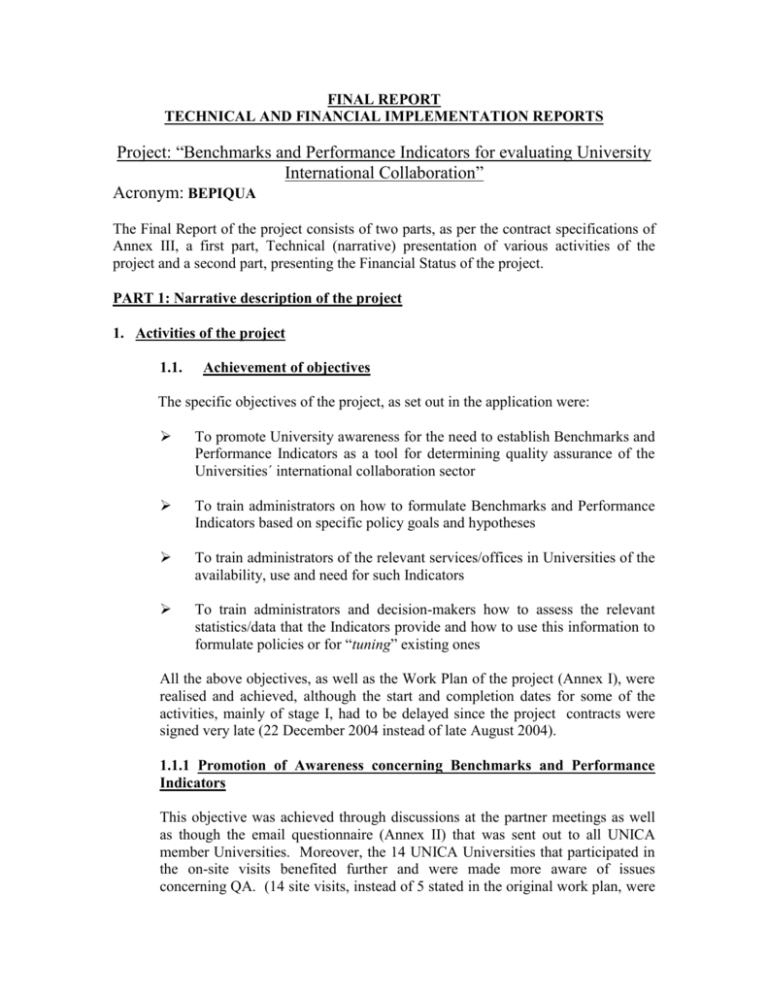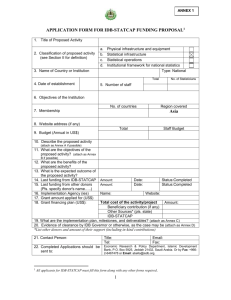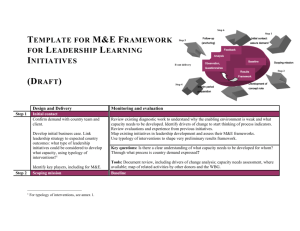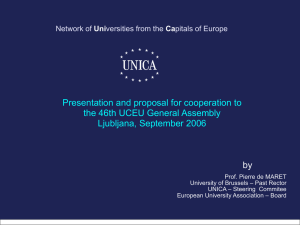Final Report
advertisement

FINAL REPORT TECHNICAL AND FINANCIAL IMPLEMENTATION REPORTS Project: “Benchmarks and Performance Indicators for evaluating University International Collaboration” Acronym: BEPIQUA The Final Report of the project consists of two parts, as per the contract specifications of Annex III, a first part, Technical (narrative) presentation of various activities of the project and a second part, presenting the Financial Status of the project. PART 1: Narrative description of the project 1. Activities of the project 1.1. Achievement of objectives The specific objectives of the project, as set out in the application were: To promote University awareness for the need to establish Benchmarks and Performance Indicators as a tool for determining quality assurance of the Universities´ international collaboration sector To train administrators on how to formulate Benchmarks and Performance Indicators based on specific policy goals and hypotheses To train administrators of the relevant services/offices in Universities of the availability, use and need for such Indicators To train administrators and decision-makers how to assess the relevant statistics/data that the Indicators provide and how to use this information to formulate policies or for “tuning” existing ones All the above objectives, as well as the Work Plan of the project (Annex I), were realised and achieved, although the start and completion dates for some of the activities, mainly of stage I, had to be delayed since the project contracts were signed very late (22 December 2004 instead of late August 2004). 1.1.1 Promotion of Awareness concerning Benchmarks and Performance Indicators This objective was achieved through discussions at the partner meetings as well as though the email questionnaire (Annex II) that was sent out to all UNICA member Universities. Moreover, the 14 UNICA Universities that participated in the on-site visits benefited further and were made more aware of issues concerning QA. (14 site visits, instead of 5 stated in the original work plan, were 2 realised, although at no extra cost to the project, since an attempt was made to cover cities with more than one university). For the site visits a common questionnaire (Annex III) was developed to enable the visiting experts to formulate their findings in a standardised way, and hence facilitate ease of comparison of findings between the universities visited. 1.1.2 Promotion of Awareness concerning Benchmarks and Performance Indicators This objective was achieved through a one-day Quality Assurance Workshop, hosted by Tallinn University of Technology on 29 April 2005 (Annex IV gives the training programme). Through targeted plenary presentations as well as Group Workshops, the participants were able to discuss, brainstorm and eventually synthesise their ideas and findings based on the project survey and background material presented to them. The background material was prepared by the invited speakers and the Coordinator, with the assistance and very useful inputs by the other 3 members of the Technical Committee. Based on the findings of the survey (email and site visits) a tentative glossary of “generic” Benchmarks and Performance Indicators was presented. Following the discussions and inputs from all participants at the QA Workshop these were finalised and appear as Annex II of the Action Plan (Annex VI) for implementing Benchmarks and Performance Indicators, (B&PI´s), produced after the Workshop. The final format of the Action Plan was agreed at the last Technical Committee Meeting. 1.1.3 Train Administrators on how to use QA tools Part of the training of the QA Workshop was the presentation of the use of B&PI´s and their contribution to assessing institutional performance in international collaboration as well as using these data to predict future institutional targets and in particular to predict specific objectives such as: Number of outgoing/incoming students/teachers Determine incoming external funds for projects Determine propositions of required co-funding for institutional funds Determine the total value of externally funded projects in which institutions participate Predict from previous 5-year trends future 5-year targets Assist universities to formulate new policies based on targets or new predictions as well as to reformulate policies which may be facing problems 3 To comprehend the need for using IT and in particular databases which can produce “automatically” the required B&PI´s, which can then be used, suitably modified, to present via the web site and publications the institution’s international collaboration “profile”. 1.1.4 Assessment and use of QA data In the explanation and presentations given but particularly in the last Workshop plenary session and discussion, the use of B&PI´s, the need of establishing QA mechanisms, the use of feedback in reformulating existing goals and policies were demonstrated. Particular emphasis was placed on the use of previous trends, how to predict the following 5-year targets based on the previous 5-year performance and how to take corrective action in particular problematic cases. 2. Organization of Partnership UNICA consists of a membership of 39 universities. Given this reality it would have been difficult to involve everyone in the day-to-day running of the project. Under these circumstances the partnership was organised as follows: Partners’ Meetings (all members) Technical Committee (Coordinator, UNICA Secretary General and 2 member Universities, 4 persons) 2.1 Technical Committee Apart form the Partners’ Meeting there was a standing 4 person Technical Committee, as described above. The Project Management format adopted ensured flexibility in decision-making and monitoring, as well as easier comparability of results from the on-site visits due to the involvement of only 4 persons. This also meant that the 4 members of the Technical Committee could more easily be trained to carry out the site visits and handle the material involved. Moreover, the inputs required for the various questionnaires and Action Plan were more easily secured through the Technical Committee. 2.2 Partners’ Meetings The first of these was held during the proposal preparation phase of the project (before submission) and approved the concept, aims and financial basis of the project. An Interim Partners’ meeting was held during the QA training Workshop in Tallinn, which acted as a substitute for the final partners’ meeting and discussed many issues relating to the closure of the project. 4 The final partners’ meeting will be held in November, after the project’s closure where the Final Report will be presented to all partners. An email version will be sent in advance for comments. The other partners were fully informed, through email, at every main stage of the project of its progress and of course were given all the deliverables. These were the “Survey of present situation pertaining to the use of QA in international collaboration” (Annex V) and the “Action Plan for implementing Benchmarks and Performance Indicators for evaluating International collaboration”, (Annex VI). The above deliverables are also available on the UNICA web site for every interested party to download. 3. Methodology, tools and technology used 3.1 Methodology The whole concept of the approach used was based on determining the present situation “where we are now” and the target date (2010) requirements of “where we want to go”. Through the presentations, interventions and QA Workshop discussions, these determined “how to get there”. In order to determine the present “baseline” situation email questionnaires had to be used, since site visits to all UNICA member universities would have been financially prohibitive. Moreover, even in the cases of the site visits, the relevant site visit questionnaire was sent in advance by email to the hosting University. 3.2 Tools and Technology The basic investigative tool was the questionnaire via email. The basic training tool was the “brainstorming” approach in Workshop Groups. The Working Groups were preceeded by presentations designed to provoke discussion but also inform and educate and through discussion and interventions by “facilitators” the final outcomes were formulated. Before the close of the Workshop the “days findings” were presented in coded form and the participants had the opportunity to “finalise” the agreed results. 4. Transversal issues This issue does not apply to this project. 5 5. Feedback on the implementation of the project The project deadlines and main deliverables were adhered to according to the initial Work Plan submitted with the project proposal. The time deviations occurred at the commencement of the project due to the lateness (5 months) in the signature of the project contract. However time was “made-up” during the second and third stages and was almost according to plan by the end of stage 3. A vital issue that would help projects in the future, particularly those of a one year duration, is the prompt signing of the contracts since any time delay can seriously affect the work schedule of the project. The low funding ratio to own funding (30%) of Accompanying Measures Programmes means that partnerships have to secure at least 70% of co-funding (from own sources), which limits the type of activities that can be supported by this type of funding. A more generous EC grant will facilitate more “adventurous” projects. 6. Products, results and their dissemination 6.1 Project Products and Deliverables The main products of this project are the following: 6.2 email survey questionnaire on determining the existing situation pertaining to QA techniques and the use of Benchmarks and Performance Indicators in evaluating University International Collaboration (Annex II). On-site visit questionnaire in order to determine in depth the existing situation concerning the use of QA techniques, particularly in international collaboration (Annex III) Results of a survey to determine the situation pertaining to the existence of a Quality Assurance System for University International Collaboration (Annex V) Action Plan for the implementation of Benchmarks and Performance Indicators for evaluating University International Collaboration (Annex VI) Availability for all interested parties of the above Survey and Action Plan, which may be downloaded from the UNICA web site: www.ulb.ac.be/unica. Elements of Good Practice Before finalising the email and on-site visit questionnaires, these were first tested for comprehension, understanding basic principles and comparability of results amongst the members of the Technical Committee and the personnel of the 6 International and Research Offices of the Service for Research, International and Public Relations of the University of Cyprus. Once the issue of formulating the questions and their format was solved and it was ensured that the answers to be given would not be obtained from questions that were designed to imply them, then the questionnaires were circulated. Before sending them out the methodology of classifying and comparing the results from the various universities was also ensured. 6.3 Dissemination Apart form the UNICA web site the results of the Action Plan and Survey will be presented at the Annual Conference of the European Association for International Education (EAIE) in Krakow, 15-17 September (Unica session 7.06 “Benchmarks and Performance Indicators for international collaboration”, Saturday 17 September 2005). It is hoped that either the European Commission and/or the EUA will consider to disseminate further the findings of this project through their own channels. UNICA does not wish to hold any intellectual property rights or copyright nor does the question of commercialisation apply to this case. PART 2: Financial Status of Project. The following tables present the financial status of the project. AM/PD (Programmes: Bepiqua Final Report)







